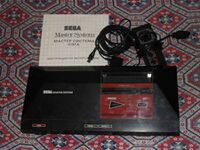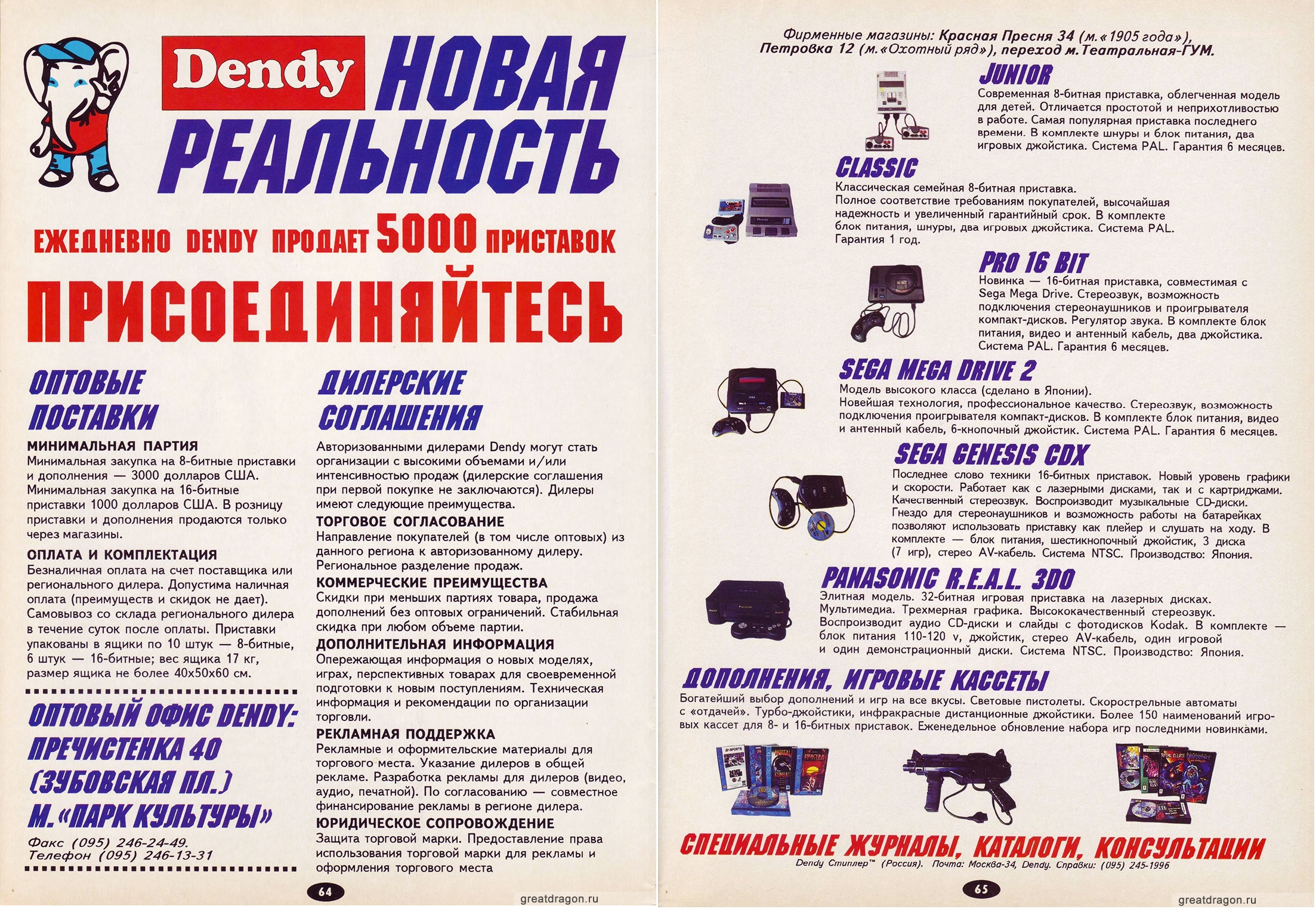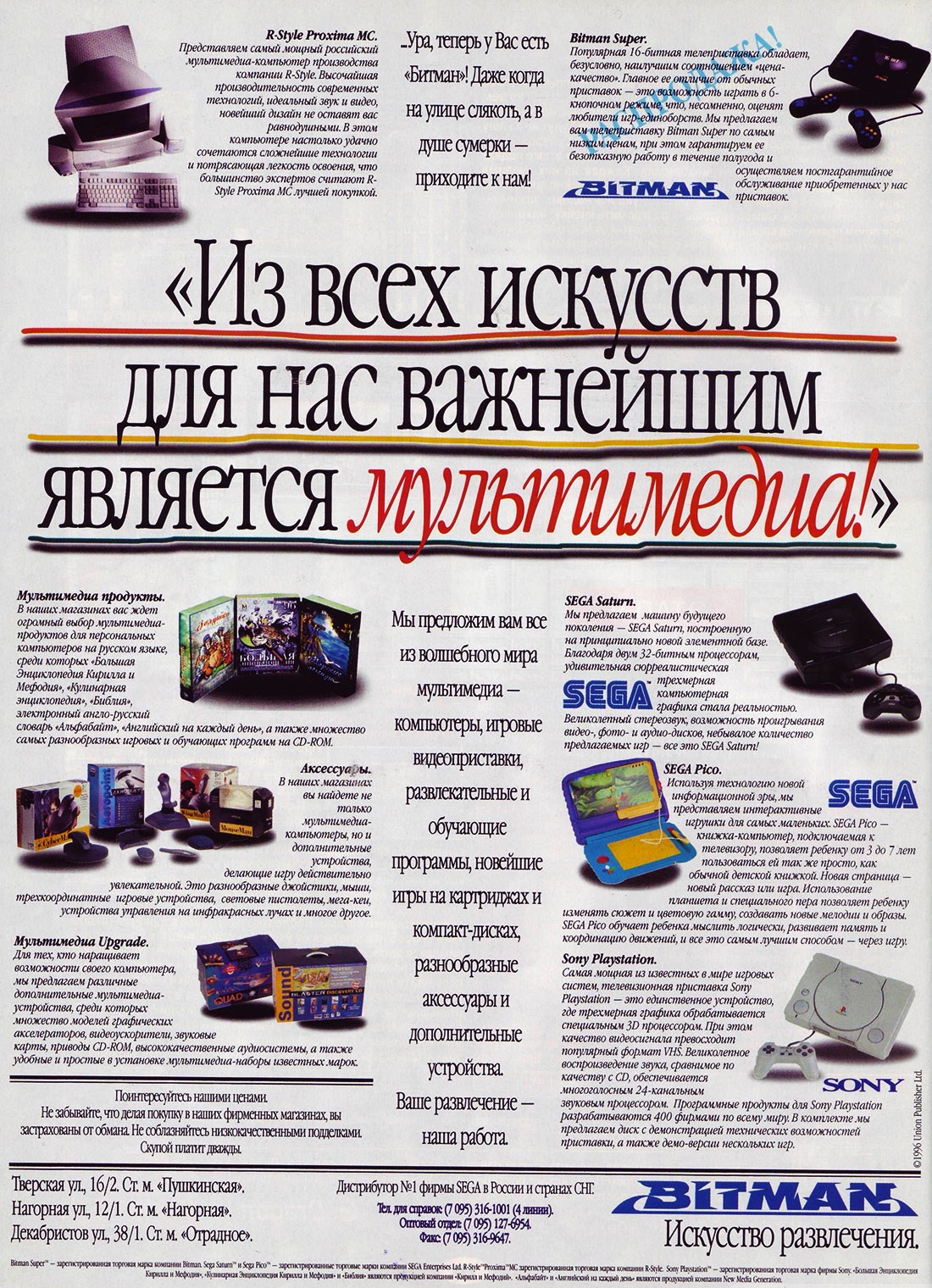Difference between revisions of "History of Sega in Russia"
From Sega Retro
Lukdriver14 (talk | contribs) |
Lukdriver14 (talk | contribs) |
||
| Line 108: | Line 108: | ||
The company also owned the rights to several other brands such as Game Boy, Liko and Simba. The last one had a company called [[Simba's Video Games]].They produced famiclons but with the acquisition of rights to Mega Drive they also began to release clones of this console. This clones became popular. Most of them looked like Playstation.The company also produced accessories for console such as [[Vzlomshchik Kodov]]. | The company also owned the rights to several other brands such as Game Boy, Liko and Simba. The last one had a company called [[Simba's Video Games]].They produced famiclons but with the acquisition of rights to Mega Drive they also began to release clones of this console. This clones became popular. Most of them looked like Playstation.The company also produced accessories for console such as [[Vzlomshchik Kodov]]. | ||
| − | {{ | + | {{gitem|1000 igr dlya 16 bitnykh pristavok SEGA.pdf|page=499|Print advert in ''1000 igr dlya 16 bitnykh pristavok Sega'' (RU) : "" (1999-xx-xx)}} |
| − | |1000 igr dlya 16 bitnykh pristavok SEGA.pdf|1000 igr dlya 16 bitnykh pristavok | ||
| − | }} | ||
==New Game Consoles== | ==New Game Consoles== | ||
Revision as of 12:41, 9 November 2019

|
| History of Sega in Russia |
|---|
| Official Sega distributor(s): Forrus (1994-1995), Buka (1995-1999), Bitman (1996-1997), R-Style (1997-1999), NVT (2000-2002) , 1C-SoftClub (2004-present) |
The modern state of Russia (known officially as the Russian Federation), emerged as an independent state in December 1991, following the demise of the Soviet Union (USSR). The move from a one-party communist state to a more Western-style capitalist society, meant that luxary items such as video games were able to become more widespread. Sega has been involved in the region in various guises since at least 1990.
Contents
- 1 Sega Master System
- 2 Dendy
- 3 Forrus
- 4 Competition
- 5 Bitman,R-Style and Buka
- 6 PC Games
- 7 Game crisis in Russia
- 8 Simba's Video Games
- 9 New Game Consoles
- 10 Sega Dreamcast
- 11 1C-SoftClub
- 12 Konstanta Plyus
- 13 AtGames Presence
- 14 Srednesrochnyye finansovyye i real'nyye investitsii
- 15 Sega Mega Drive Mini
- 16 Homebrew Games
- 17 KidsPlay
- 18 Sititek
- 19 References
Sega Master System
While video games had existed in Russia during the days of the Soviet Union (Tetris being the most well-known example of a Russian video game export), virtually no Western video game companies chose to sell their products inside the bloc.
Curiously Sega had a go at selling the Sega Master System (model no. MK-3096-19) inside the Russian SFSR in 1990. The elusive Russian Master System outputs a SECAM signal (for compatiblity with the Soviet TV standard) and lacks both a card slot and reset button, much like redesigned Master System II console seen elsewhere. Little is known about the console's fortunes, though given its rarity, it is unlikely to have been a success.
Dendy
Russia's video game market is widely considered to have been created when Russian importing company, Steepler, created the "Dendy", an own-branded Nintendo Famicom sourced from Taiwanese manufacturers. At the time, no legislation existed in Russia to protect video game copyrights - while cloning games and hardware was both illegal in much of the world, the Dendy and its derivatives were perfectly legal in Russia - Nintendo could not stop the console's distribution, and didn't.
With a fully fledged marketing campaign, Steepler was able to dominate its home market, but the economical situation in Russia meant that Dendy was out of reach of most consumers, costing several months' worth of the average worker's salary (and indeed in 1993 it was estimated that 39-49% of the population was classed as being in poverty). Steepler were able to bring the costs down as the years went on however, bringing the console into a more affordable price range around 1994.[1]
Forrus
In 1993 Nissho Iwai (a Japanese firm which had operated in Russia for decades) got the rights to sell Sega consoles in Russia. The company decided to look for a distributor who wabt to sell consoles in the country. Negotiations have started with Steepler who, seeing the success of Sega Mega Drive in Europe, also wanted to repeat it in Russia. Nissho Iwai was ready to start cooperation but the company wanted from Steepler to break all contracts with Taiwanese companies that produced Dendy. Steepler did not want to do this and in 1994 the negotiations ended.
Seeing the success of the Dendy, other distributors tried to get into the act, and through Nissho Iwai and its chosen distributor, Forrus, Sega re-entered the Russian market around August 1994. Sega would sell stock to Nissho Iwai, who would sell it to Forrus, who would distribute to retailers across the country.[2]
Under this arrangement, the Sega Mega Drive (model 1 and 2), Sega Master System (model 1 and 2), Sega Mega-CD (model 2), Sega Game Gear were officially sold in Russia, with the same selection of PAL games seen in Europe (at least, in regards to first-party releases). However despite widespread publicity and even the commissioning of a weekly television show promoting Sega products, the endeavour appears not to have been a particular success, with the distribution rights getting given to a new company.
In 1995, Sega got along with Kenga (a company that produces Mega Drive clones) to distribute Sega Multi Mega.
Expression error: Unexpected < operator. File:Migr 1 RU.pdfFile:Migr 1 RU.pdfFile:Migr 1 RU.pdf
Competition
Not content with just marketing Dendy consoles, Steepler used its position of market leader to market its Mega Drive clone, the Pro 16 Bit. Its distribution channels and associated Dendy brand helped drive sales across the nation - at this point the Dendy was synonymous with video games in general, leading to curious situations were consoles would be referred to as "Nintendo Dendys" or "Sega Dendys". Steepler also distributed its products around the wider CIS region (formed by former republics of the USSR) and Baltic States , giving it a territorial advantage over Forrus which in 1994 had only 25 sellers and only in Moscow.
Steepler decided to go further and registered the Mega Drive trademark on June 10, 1994. This meant that according to Russian law, they had the right to sell Mega Drive despite Sega's disagreement. The trademark case would be repeated in Sega's history in this country it will be present even today.
Steepler and Dendy sold games from USA, Asia and pirate versions.Consoles sold by them are Sega Mega Drive produced in Taiwan which looked almost the same as the original consoles ,Mega Drive from Singapore ,Japanese version of Mega Drive and Sega Genesis CDX from USA.In June 1994, Steepler sold 4,000 Sega Mega Drive but planned to increase sales in the autumn from 10,000 to 15,000 for a month.
Its Sega operations were cut short in end of 1994, however, when Steepler was chosen as representative of the Nintendo in all former USSR countries.In Russia and CIS countries, the newly created Dendy company was selected as an exclusive distributor. While the agreement permitted the unlicensed Dendy consoles to be sold, sales of rival products (such as Sega) was restricted.Sega products were sold by Dendy with restrictions but Steepler could sell Sega consoles normally.[3] The high cost of importing original SNES consoles and cartridges from Germany affected the Steepler, which was declared bankrupt in 1996.
Another major competitor to Forrus was Bitman, established in November 1994. In addition to marketing NES clones, the company launched its own Mega Drive, the Super Bitman, based on the infamous KW-501 clone console.
Other competitors included Kenga and its Mega-Ken Mega Drive clone, and Subor with the SB-16C. The true number of smaller organisations selling imported software or accessories is not known.
Bitman,R-Style and Buka
At the beginning of 1995 Buka became representative of Sega. During the co-operation with Sega sold: Mega Drive II (European PAL and Asian PAL), Sega Saturn (Asian NTSC and later European PAL) , Mega CD II (Asian NTSC and European PAL), Sega Game Gear (European PAL),Master System 2 (European PAL) and Sega 32X (European PAL).
Some games have description in Russian , such as Sonic 2, Exo-Squad, Primal Rage. Also in 1996, the Russian version of Sega Pro was also created.
Buka also managed to get along with Steepler and Dendy for the sale of original models but company sold them at a more expensive price than unofficial.
Presumably displeased with Forrus' efforts, Bitman was chosen as an official Sega distributor for Russia.Negotiations lasted about a year. In January 1996, an agreement was signed under which the Russian company Bitman became the distributor No.1 of Sega Europe in Russia and the CIS countries[4]. At a joint press conference on June 6th, 1996 this fact was officially confirmed and detailed plans for distribution were presented. With its own chain of stores, Bitman was able to distribute the Mega Drive 2, Sega Saturn , Sega Mega-CD model 2 , Sega Game Gear, Sega 32X and Sega Pico in addition to the Super Bitman all in the European PAL system.[5]Sega, despite the fall of Steepler, did not register the Mega Drive brand in Russia, which meant that Dendy decided to reserve the rights for the next few years.
In 1997, Bitman was acquired by R-Style, who inherited Sega's distribution agreement. R-Style continued selling the Saturn (European PAL and NTSC-U) , Mega Drive II (European PAL) , Mega CD II (European PAL) and Pico (European PAL) in the region until the end of the 1990s.
In 1998, it was estimated that there are hundreds of thousands of Sega Mega Drive consoles in Russia (including original consoles and clones). In 1998, the game Monopoly (Mega Drive) was translated into Russian, but it is not known whether it was officially.
New problem for official distributors were the importers who imported consoles and games to Russia.This caused that games and consoles that were to be released later in the country appeared a few days after the premiere in the world.Game Land was one of the better known importers.Importers released Sega Nomad in Russia in 1997.Because the console couldn't work with PAL cartidges , local distibutors decided to promote Mega Key to pass regional blockade. Accessories for Mega Drive were also imported such as controllers and even XB∀ND.
also published in:
- Strana Igr (RU) #1 (1996-xx-xx)[6]
also published in:
- Magazina Igrushek (RU) #10: "6/1996" (1996-xx-xx)[7]
PC Games
The Russian PC market for many years was under strong piracy pressure. Compilations that contained many games on one disk appeared as the first. Then came Russian pressed bootlegs that became very popular in the former USSR countries and in former Warsaw Pact countries such as Poland. They were games with covers in Russian. The games were of good quality so at first many people thought that these were original games. Along with their popularity, the first translations of games into Russian appeared also illegal translations of Sega games such as Sega GT by 7th Wolf.
Game crisis in Russia
In 1998, the economic crisis began in Russia. Original games began to cost huge amounts. This resulted in a very high level of computer piracy (95%). Pirate titles were widely available, within a few days of their release, outside of every Moscow metro station. Many realized that official distribution has no future in Russia.
As a leading software publisher in Russia, the CIS and the Baltic States, Buka has seen this problem since it was founded in 1993 and used various methods to limit its impact. They decided to take a risky step, releasing two versions of games, a full box version with instructions (and a small surprise), as well as a cheaper version in the jewel case to compete with pirates in terms of price. The customer has chosen a legal product.
In 1999, Buka decided to stop selling Sega consoles and focus on selling computer games and games created by him.R-Style decided that same year that he began selling everything about computers.Although piracy still existed, the government and other companies tried to fight it.
Simba's Video Games
With the collapse of Dendy in crisis, the rights to Mega Drive in 1999 were registered by Mezhregional'naya obshchestvennaya organizatsiya sodeystviya proizvodstvu i realizatsii videoigr.Sega didn't have a representative in Russia at the time, so it couldn't react.
The company also owned the rights to several other brands such as Game Boy, Liko and Simba. The last one had a company called Simba's Video Games.They produced famiclons but with the acquisition of rights to Mega Drive they also began to release clones of this console. This clones became popular. Most of them looked like Playstation.The company also produced accessories for console such as Vzlomshchik Kodov.
Expression error: Unexpected < operator. File:1000 igr dlya 16 bitnykh pristavok SEGA.pdf
New Game Consoles
In 1999, new Mega Drive clones from the New Game appeared on the Russian market.To avoid problems with the use of Mega Drive name, the company named its clone Magistr Drive. The company translate Mega Drive games into Russian.
Sega Dreamcast
The Sega Dreamcast also made it to the country.In 2000 NVT was appointed a distributor and started selling consoles.[8]The Sega Dreamcast console was presented in Russia on Comtek 2000 which took place from 17 to 21 April 2000.[9]On November 10, 2000, the distributor began selling the console pre-release and promised its official release at the end of the year.Consoles were sold along with Russian documents.
The end of 2000 was marked by a boom for DC consoles in the CIS countries, which was related to the mass distribution of Russified versions of games (pirated ones) and the decrease in prices of the console and games thanks to official distribution.[10] Until now, consoles could be bought from imports (usually from Japan) at a high price.
Despite the failure of Dreamcast in the world, in the CIS countries the console was well received and could be bought until the end of 2003.
With the popularity of the console, several local distributors decided to buy consoles from Sega and sell them on their own. It happened in 2001–2002 when Big Ben Interactive became a distributor in Western Europe.Local distributors bought consoles cheaply from them and began to distribute Dreamcast along with self made instructions in Russian.
Pirate games translated into Russian were very popular on the market. After some time they became more widespread than the original games.This games were distributed with custom-made packaging.There were a few companies that translated and sold pirate games:
At the time Dreamcast was distributed in Russia, Mega Drive clones could still be found on the market. The most popular were Mega Drive 4, Simba 268, Magistr Drive 5, Mega Drive X.New among these clones were educational consoles, which according to the producers, in addition to the possibility of games, taught foreign languages. These consoles included Obuchayushchiy Magistr and Obuchayushchiy Bakalavr.
1C-SoftClub
In 2004 SoftClub became a distributor of Sega in Russia and CIS, which became a part of the company 1C.More modern games for the PlayStation 2 and beyond seem to be distributed in Russia legally without much concern. The country seems to have adopted the PEGI rating system and games are translated into Russian in a similar manner to other European regions.
Konstanta Plyus
In 2006, the rights to the name Mega Drive were sold to Konstanta Plyus.They released a series of devices on the Russian market called Mega Drive Portable. Games were placed in custom-made Game Boy Advance-style cartridges and are compatible in a number of different devices, most of whom steal design tips from Nintendo consoles.
AtGames Presence
AtGames products are present in this region and are distributed by Cyber Toy. A good chunk of their consoles have been released in the region, including the Arcade Classic and the Arcade Ultimate. Blue and green versions of the Arcade Ultimate appeared in Russia before other regions of the world (namely the UK, in which Blaze Europe introduced the blue variant in 2011), suggesting strong support from AtGames in that region.
The Micro Drive is currently exclusive to Russia.
Srednesrochnyye finansovyye i real'nyye investitsii
In 2017, Srednesrochnyye finansovyye i real'nyye investitsii bought the rights to the Mega Drive name.However, the company has not released any Mega Drive clone since 2017.Despite this, other pirates on the market are still trying to avoid breaking Russian law and do not use the name Mega Drive in their copies, such as Super Drive, Titan, Retro Genesis, Magistr X and others.
Sega Mega Drive Mini
Sega said there are no plans to release Sega Mega Drive Mini in Russia.
Homebrew Games
There appears to be a strong homebrew Mega Drive community in Russia, with many of their creations leaking into the commercial market by dodgy eBay sellers.
KidsPlay
Since 2006, the distribution of arcade machines and equipment for children produce by Sega is being carried out by KidsPlay.[11]
Sititek
Sititek is the official distributor of Sega Toys in Russia and CIS countries.[12]
References
- ↑ http://tv-games.ru/wiki/Companies/Steepler.html
- ↑ https://www.kommersant.ru/doc/10153
- ↑ https://www.kommersant.ru/doc/94004?query=steepler
- ↑ File:Migr_8_RU.pdf, page 91
- ↑ https://www.kommersant.ru/doc/233963?query=bitman
- ↑ Strana Igr, "" (RU; 1996-xx-xx), page 53
- ↑ Magazina Igrushek, "6/1996" (RU; 1996-xx-xx), page 100
- ↑ https://web.archive.org/web/20010409225930/http://sega.ru:80/news.phtml
- ↑ https://web.archive.org/web/20001027092245/http://www.nd.ru/news/news100.shtml
- ↑ File:Radio 2001-12 RU Dreamcast.gif
- ↑ http://brunswickbowling.kz/about/sng.php
- ↑ https://www.fansimag.ru/tovary-dlya-detey/domashniy-planetariy/disk-proekcionnyy-sititek-dlya-planetariev-homestar-romanticheskiy-6743/







